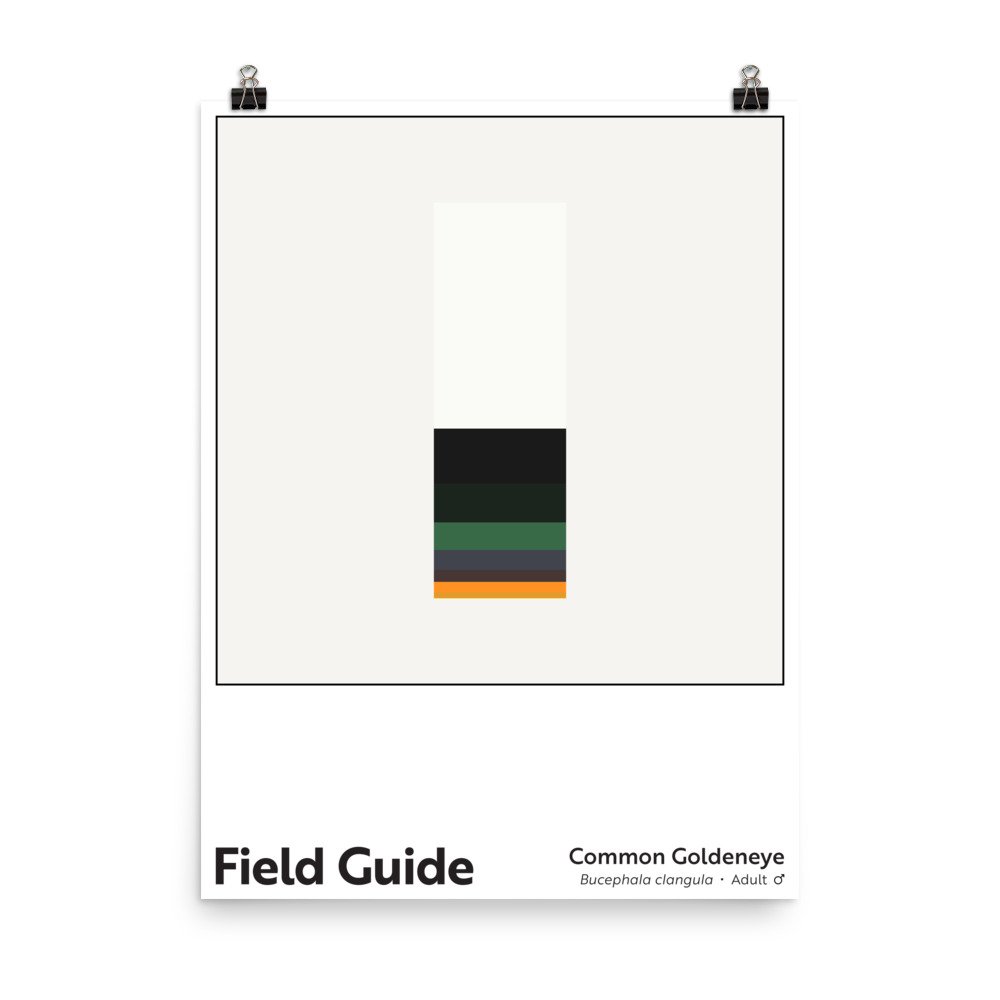 Image 1 of 3
Image 1 of 3

 Image 2 of 3
Image 2 of 3

 Image 3 of 3
Image 3 of 3




Field Guide : Common Goldeneye (Male)
Unlimited edition. 18 x 24 inch, museum-quality poster on matte paper.
Growing up on the East Coast, I don’t recall seeing common goldeneyes, but I’m sure the handsome winter visitors were occasionally around. Here, in Sonoma County, California, I see them fairly often during the cold months. Looking at the striking adult drakes, I’m always taken with the play of light on their alternately “black,” dark green, and brilliant green heads. Iridescence presents a challenge for this project, though. I studied photographs of many drakes in even, neutral lighting, and found the illuminated head color to be a mid shade of green (similar to the paint color Hooker’s green). Of course, as light plays over the iridescent head of a living bird, you will see many varieties of green (emerald, mint, Kelly green, avocado), but this project compels me to suss out the most representative, neutral colors for the column.
Given the bird’s name and marvelously distinctive eye, you might think that the pop of orange and mustard at the column’s base is a nod to that feature, but, in fact, those colors are drawn from the bird’s feet. The creamy lemon eye color represents the smallest total percentage so its band is at the very bottom, under that mustard; at this scale (and especially online), a detail is needed in order to see it.
Interestingly, about 80% of breeding common goldeneye pairs are already together when they arrive on their northern breeding grounds to select a nesting cavity. Tree hollows, woodpecker excavations, and human-made nesting boxes are preferred targets, but goldeneyes have reportedly nested in rock crevices, unused chimneys, and even abandoned rabbit burrows. If a hen (female) has had a successful brood at a particular nesting site one year, she is likely to return to the same site in following years. The drake goldeneye doesn’t hang around to help, however; although goldeneyes typically form their breeding pair bond early, the male plays no part in egg incubation or duckling care. In fact, he departs 1-2 weeks after incubation begins.
Note: These archival poster prints feature rich, appealing colors. I encourage customers to take care in handling them until they are framed/protected for display; the darker colors on the matte paper can be scratched. They ship rolled, so customers need to flatten them before framing (or have their framer do so).
Charitable Sales Model: Whenever one of these poster prints is purchased, a charitable contribution equal to 10% of the print’s cost (or $3.60) is made to a nonprofit working to tackle environmental or social challenges. Read more about my charitable sales model here.
Unlimited edition. 18 x 24 inch, museum-quality poster on matte paper.
Growing up on the East Coast, I don’t recall seeing common goldeneyes, but I’m sure the handsome winter visitors were occasionally around. Here, in Sonoma County, California, I see them fairly often during the cold months. Looking at the striking adult drakes, I’m always taken with the play of light on their alternately “black,” dark green, and brilliant green heads. Iridescence presents a challenge for this project, though. I studied photographs of many drakes in even, neutral lighting, and found the illuminated head color to be a mid shade of green (similar to the paint color Hooker’s green). Of course, as light plays over the iridescent head of a living bird, you will see many varieties of green (emerald, mint, Kelly green, avocado), but this project compels me to suss out the most representative, neutral colors for the column.
Given the bird’s name and marvelously distinctive eye, you might think that the pop of orange and mustard at the column’s base is a nod to that feature, but, in fact, those colors are drawn from the bird’s feet. The creamy lemon eye color represents the smallest total percentage so its band is at the very bottom, under that mustard; at this scale (and especially online), a detail is needed in order to see it.
Interestingly, about 80% of breeding common goldeneye pairs are already together when they arrive on their northern breeding grounds to select a nesting cavity. Tree hollows, woodpecker excavations, and human-made nesting boxes are preferred targets, but goldeneyes have reportedly nested in rock crevices, unused chimneys, and even abandoned rabbit burrows. If a hen (female) has had a successful brood at a particular nesting site one year, she is likely to return to the same site in following years. The drake goldeneye doesn’t hang around to help, however; although goldeneyes typically form their breeding pair bond early, the male plays no part in egg incubation or duckling care. In fact, he departs 1-2 weeks after incubation begins.
Note: These archival poster prints feature rich, appealing colors. I encourage customers to take care in handling them until they are framed/protected for display; the darker colors on the matte paper can be scratched. They ship rolled, so customers need to flatten them before framing (or have their framer do so).
Charitable Sales Model: Whenever one of these poster prints is purchased, a charitable contribution equal to 10% of the print’s cost (or $3.60) is made to a nonprofit working to tackle environmental or social challenges. Read more about my charitable sales model here.